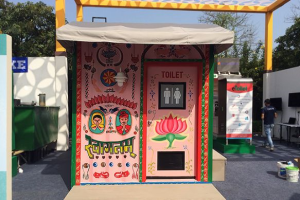Source: takepart.com
Published: December 12, 2014
An innovative group of Caltech students is betting on a creative design that can be shipped anywhere around the world.
Jessica Dollin
Here’s a lofty goal for a group of college students: Design a self-cleaning mobile toilet that conserves water and energy and recycles waste.
The five Caltech undergrads who did just that won the 2012 Bill & Melinda Gates Foundation Reinvent the Toilet Challenge—and they saw their design come to life in November. With support from the foundation and American manufacturing company Kohler, the group is providing India with solar-powered toilets made from shipping containers—a portable invention that aims to mitigate the country’s sanitation problem.
Modern plumbing isn’t ingrained in Indian culture because toilets aren’t widely available, nor are they commonly used. Beliefs about hygiene, cleanliness, purity, and sanitation vary depending on religion and cultural practice; for example, some groups don’t consider children’s feces harmful. The Caltech students’ mobile restroom, which uses chemicals and solar energy to process waste, is painted colorfully to match graphics commonly seen in local culture, and it incorporates vibrant tiles and murals from Indian painters to help reduce the stigma of using restrooms.
The winning design operates on less than five cents a day. The solar panels convert sunlight into energy that breaks down waste and water that have been flushed. The waste is transformed into fertilizer; then the water is pumped, treated with chemicals, and recycled back into the toilet or used for irrigation. The bathroom also includes a urinal and a sink.
(Photo: Facebook) The bathrooms can be “transported
anywhere in the world,” according to Caltech professor
Michael Hoffmann. 
Another requirement of the challenge was to improve mortality rates of the population. Water pollution from defecation can cause diarrhea and cholera, and residents often use contaminated water for drinking, washing, and cooking—spreading parasites.
Encouraging the use of toilets also reduces the amount of pollutants in the air. Open defecation and urination emit greenhouse gases, specifically pollutants that affect ozone in the troposphere.
Perhaps the most crucial aspect of the design, however, is that the bathrooms are realistically applicable for use in rural parts of the world.
“We’ve built the unit in a shipping container, which could be transported anywhere in the world,” said Michael Hoffmann, a Caltech professor working with the students.
The team is tackling cultural barriers to improve sanitation by slowly integrating the designs into Indian society, starting first in cities and at universities.
“We wanted to put the toilets in places where toilets were already familiar [so] we could be sure that people would use them,” said Cody Finke, one of the Caltech students. Later, the team plans to integrate the bathrooms into rural places where toilets are less familiar and gauge how open residents are to the idea.
Five bathroom models are being tested, and the next steps will be production and distribution. Ultimately, the team looks to expand the toilets into homes and public spaces.

